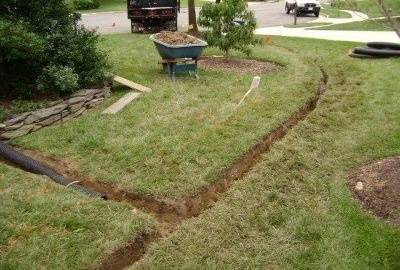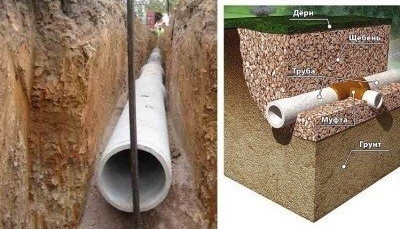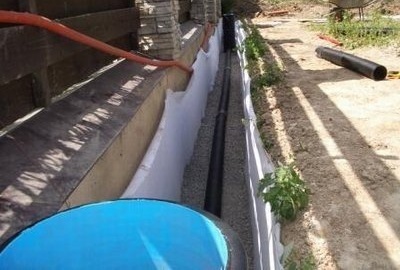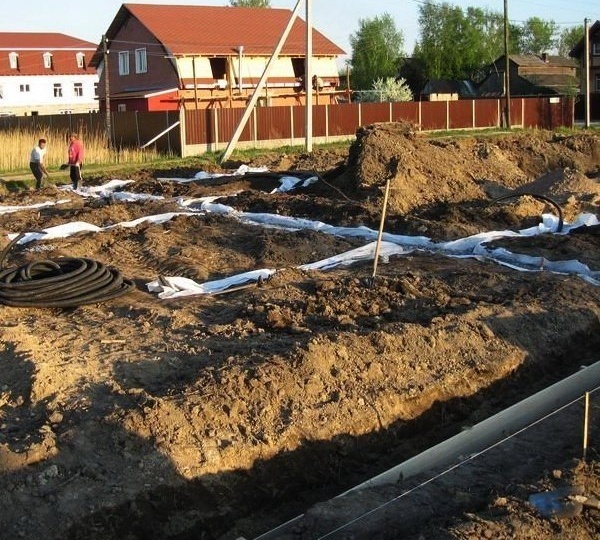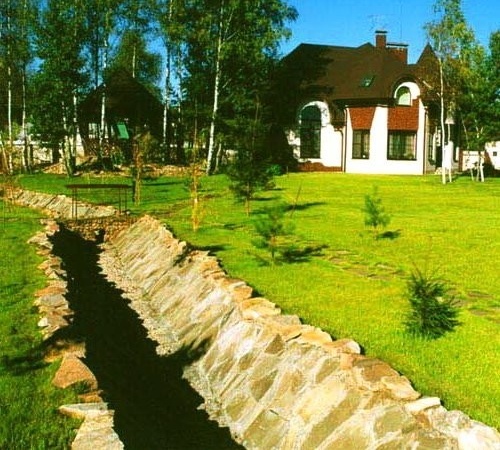DIY punching perforated drainage pipes + overview of possible drainage schemes
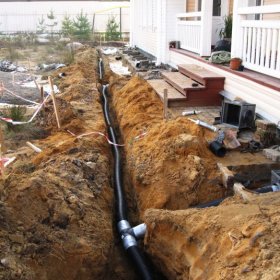
Moisture, contrary to popular belief, can not always be considered the best friend of plants. Too much water is harmful to most of them. Excess moisture is also not useful for buildings, it destructively affects the materials of the building. That is why it is very important for each owner of a suburban area to divert excess water from their territory. A solution to the problem will be a drainage pipe: do-it-yourself installation of such a design is possible for almost every home craftsman.
Content
What is drainage and why is it needed?
The newly-made owner of a suburban area often has to work hard before he can fully enjoy his vacation in the lap of nature. Most land plots suffer from waterlogging.
Having built a house on such a plot, one may encounter the problem of destruction of the foundation and difficulties in arranging the personal plot. To drain excess moisture, a drainage is mounted - an artificially constructed waterway in the soil. It is a special system of underground channels or pipelines. The water that enters them is collected in special storage tanks or discharged off-site.
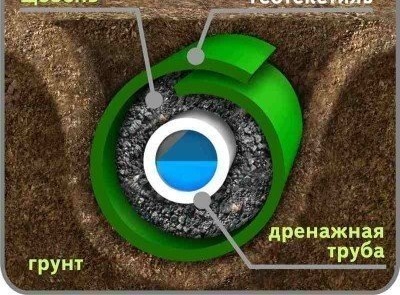
Drainage helps protect the foundation from destruction and create comfortable conditions for growing plants
Practice shows that the first alarming signs that make you think about installing a drainage are:
- a large number of hygrophilous plants on the site;
- the presence or periodic occurrence of groundwater in basements and cellars of nearby buildings;
- the appearance after rain of a large number of poorly drying puddles.
However, the absence of these signs does not mean that there will be no problems with waterlogging. It is best to invite a specialist and accurately determine the degree of moisture of the site and, if necessary, to arrange the disposal of water.
Methods of arranging a drainage structure
When thinking about how to lay a drainage pipe, you need to understand that there are several ways to install drainage structures:
- Trenches with rubble and sand. Closed drainage, which is a groove dug in the ground, filled with a layer of crushed stone, on top of which sand is laid. For the best effect, they can be performed in the form of a "herringbone", while the central trench, to which the secondary ones are suitable, should be made with a slope directed towards the water discharge point. The distance between drains is selected depending on the composition of the soil. On clay it should not exceed 10, loam - 20 and sand - 50 m.
- Outdoor drainage. The easiest to use device and the cheapest option.It is a groove, half a meter wide and about 70 cm deep, dug around the perimeter of the site. The sides in the drains are beveled at an angle of about 30 °. Water is discharged from the system into a common gutter. The main drawback of the design is its unaesthetic appearance, which slightly spoils the landscape of the site.
- Perforated Pipe Design. The most common technology for laying drainage pipes. Deep drainage designed to divert high-lying groundwater. Ceramic or asbestos-cement pipes with holes drilled in them are laid in the ground. A more modern option is perforated plastic or ready-to-install drainage systems that can be found on sale.
- Drainage trays. This is a surface drainage that allows you to remove moisture from the site, which fell on it in the form of precipitation. To equip the structure, special trays are used, which can be made of modified concrete or plastic. Trenches are conducted from the water inlets to the place of discharge, while a slight bias is necessarily observed, about 2-3 °. Parts are installed in small grooves, their sides should be at ground level. Trays are necessarily covered with decorative grilles above.
If the area is elevated, open drainage grooves are dug across the slope. Thus, it will be possible to “intercept” water flowing down from above.
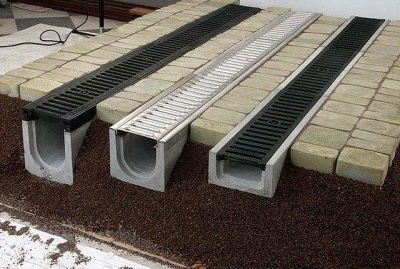
To drain excess moisture that enters the site in the form of precipitation, drainage trays are used.
Perforated Pipe Installation Instructions
Before proceeding directly to the installation, it is necessary to carry out calculations and select the appropriate material.
For design work, you will need a site layout and special data, which is best requested at the local land office:
- seasonal water table;
- soil characteristics and soil structure;
- the amount of moisture falling in the form of precipitation and flood waters.
Using these data, specialists will carry out the necessary calculations and determine the necessary depth of the trenches and the diameter of the pipes.
The most affordable solution for equipping the system are plastic parts. An extremely simple drainage pipe device requires two layers of polyvinyl chloride or polyethylene, which allows them to serve for at least 50 years at a fairly significant depth. In addition, the two-layer construction promotes self-cleaning, preventing clogging. As a prevention of clogging of holes in the pipe body with soil particles and small debris, they are wrapped with a coconut fiber cloth or geotextile before laying.
The order of the work is as follows:
- Installation of the drainage system begins with the marking of the territory, which is carried out in accordance with a pre-compiled scheme. Trenches are digging along the designated lines, the depth of which is determined by preliminary calculation. To determine the width of the structure, 40 cm is added to the outer diameter of the prepared parts. When conducting work, remember the necessary slope of the drainage pipe, which is usually at least 3 °.
- At the bottom of the prepared trench, a rubble-sand pillow is mounted. To do this, first put a layer of sand 10 cm thick. The material is well compacted. Then a layer of rubble 20 cm wide is laid on top of it.
- Pipes wrapped with geotextile are laid on the prepared base. You can cut the part of the required length with a conventional mounting knife. To connect the elements, special couplings are used. In order to prevent freezing of the system, it is recommended to lay drainage pipes deeper than the freezing level of the soil.
- After laying the pipes, their slope is checked again. To do this, you can use the usual cord stretched along the pipeline.
- In places of turns of trenches and in areas where the slope angle changes, special observation wells are required to be equipped. They are equipped with lids to prevent clogging of the structure. These facilities are necessary for monitoring and periodic cleaning of the drainage system.
- At the last stage, backfill is carried out, that is, all actions are performed in the reverse order. A layer of rubble is poured over the pipe, followed by sand, and the last layer of soil that was excavated when digging a trench. You can lay sod on top.
The output of the system is carried out in an open reservoir or rain sewer. In any case, a check valve is mounted at the end of the outlet pipe. If it is impossible to organize such a conclusion, a so-called prefabricated well is arranged. As it is filled, it is necessary to pump out water.
During installation, you should try to avoid common mistakes that lead to a violation of the drainage functionality. These include:
- The insufficient depth of the trenches, which can lead to a violation of the water balance of the site.
- The use of pipes not suitable for the type, which leads to a quick failure of the system.
- Incorrect drainage angle, which disrupts the functioning of the structure and can lead to serious problems with the water regime in the area.
Practice shows that installing drainage pipes with your own hands is a feasible measure. The only thing that must be entrusted to specialists is the calculation of the system and the drawing up of a pipe-laying scheme. Everything else is a fairly simple job. When fulfilling it, it is very important to follow the instructions, carefully monitoring the key points: the bias of the system, the reliability of the pipe connection, the organization of inspection wells, etc. A well-equipped drainage system will serve for many years, preventing excess moisture from damaging the foundation of the house and ruining the site.
